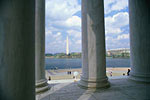
WASHINGTON -
Churches, charities and other tax-exempt organizations that paid the federal excise tax on long-distance or bundled telephone service qualify for this year�s one-time telephone excise tax refund, according to the Internal Revenue Service.
With the annual May 15 filing deadline fast approaching for many nonprofits, the IRS urges any of these organizations that paid the 3 percent tax to be sure to request this special refund. The telephone tax refund is also available to churches and small tax-exempt organizations that don�t normally file annual returns with the IRS.
The government stopped collecting the long-distance excise tax last August after several federal court decisions held that the tax does not apply to long-distance service as it is billed today. Federal officials also authorized a one-time refund of the 3 percent tax collected on long-distance or bundled service billed after Feb. 28, 2003, and before Aug. 1, 2006. The tax continues to apply to local-only phone service.
Organizations can request the refund by filing Form 990-T, Exempt Organization Business Income Tax Return and attaching Form 8913, Credit for Federal Telephone Excise Tax Paid. Organizations that obtain a credit or refund from their service providers are not eligible to file a refund request with the IRS.
If your church or organization paid the tax, here are some tips to help you figure the refund correctly and get it quickly:
-
Start by filling out Form 8913. This form is used to figure the refund, including interest. Current interest factors for corporations, including tax-exempt organizations, can be found on the telephone excise tax refund page on IRS.gov.
-
You have two choices for figuring the refund. Base your request on the actual amount of tax paid on service billed from the beginning of March 2003 to the end of July 2006, using your phone bills or other records, or estimate the amount of tax paid using a worksheet included in the instructions for Form 8913. Choosing to use the estimation worksheet may save time and paperwork, especially if you lack ready access to complete phone records for the past few years. If you file Form 990, Return of Organization Exempt From Income Tax, the amount you entered for telephone expense on Line 34 may help you figure the credit. Publication 4589, TETR for Exempt Organizations, helps explain these calculations.
-
Carry the total amount figured on Form 8913 to Form 990-T, Line 44f. Follow the instructions for completing the rest of Form 990-T. Normally, Form 990-T is used by organizations to report business activities unrelated to their tax-exempt purpose and figure the tax on these activities. If, like most organizations, you do not engage in unrelated business activities, you can just complete the top section (above Part I) of Form 990-T. Be sure to write, �Request for TETR Credit� on the top of the form.
-
Many cell phone customers mistakenly believe they are not eligible for the telephone tax refund. The refund is normally available to cell phone users, as well as land-line, fax and Internet phone customers. The method of phone signal transmission does not affect the refund.
-
The refund applies to the federal excise tax paid on both long-distance and bundled telephone service. Bundled service is local and long-distance service provided under a plan that does not separately list the charge for local service. Bundled service includes, for example, phone plans that provide both local and long-distance service for either a flat monthly fee or a charge that varies with the time for which the service is used. It is the type of service provided by many cell phone companies.
-
When figuring the refund, do not count amounts paid for prepaid phone cards and prepaid cell phones. Ordinarily, the customer is not liable for the federal excise tax on prepaid cards and phones and thus, not eligible to request the refund.
-
If you�re not sure whether you paid the tax, check the portion of your telephone bill that relates to long-distance or bundled service. Service providers use a number of different terms to identify the tax. Phrases to look for on English-language phone bills include: Federal, Federal Excise 3%, Federal Excise @ 3%, Federal Excise Tax, Federal Tax, Fed Excise Tax and FET; Spanish-language phone bills; Impuesto Indirecto Federal and Impuesto federal. Typically, this federal tax amount is not commingled with any other tax or surcharge on a customer's bill. In other words, it is normally shown as a separate line item. For information about accessing old phone records from various service providers, visit the �telephone companies� link on the Telephone Excise Tax Refund page of this Web site..
-
Use the Telephone Excise Tax Refund page on this Web site. Here, you can download forms and find answers to frequently-asked questions. You can also find special instructions for nonprofit hospitals, schools and government agencies that may have paid federal telephone taxes in error, as well as alternate procedures for political organizations.

 Printer Friendly Page
Printer Friendly Page